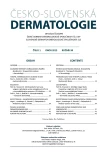Acarodermatitis – Dermatitis Caused by Mites
Authors:
L. Drlík 1; L. Pock 2; C. Babička 3
Authors place of work:
Dermatovenerologické oddělení, Šumperská nemocnice, a. s., primář oddělení MUDr. Lubomír Drlík
1; Bioptická laboratoř s. r. o., Plzeň, odborná vedoucí lékařka prof. MUDr. Alena Skálová, CSc.
2; Parazitologické oddělení, Okresní hygienická stanice Šumperk, vedoucí pracoviště RNDr. Ctirad Babička, CSc.
3
Published in the journal:
Čes-slov Derm, 90, 2015, No. 1, p. 25-33
Category:
Kazuistika
Summary
Acarodermatitis is a very common disease in clinical practice. It affects, especially, patients running their own farm. It also occurs in city inhabitants keeping pets – dogs, cats, guinea pigs or rabbits. The pets may be affected by cheyletiella. Acarodermatitis represents a remarkable interdisciplinary topic for dermatologists, veterinarians and parasitologists. Contact points are also found in dermatohistopathology. Above all, cheyletiellosis cutaneous symptoms may clinically and histopathologically imitate immunobullous dermatoses.
Key words:
acarodermatitis – Cheyletiella – histological findings
Zdroje
1. ANSARIN, H., JALALI, M. H., MAZLOOMI, S. et. al. Scabies presenting with bullous pemphigoid-like lesions. Dermatol. Online J., 2006, 27, 12, 1, p. 19.
2. AYDINGÖZY, I. E., MANSUR, A. T. Canine scabies in humans: a case report and review of the literature. Dermatology, 2011, 223, 2, p. 104–106.
3. BABIČKA, C., DRLÍK, L., BLÁHOVÁ, I., KUBÍN, J. Akarodermatitida – onemocnění způsobené roztoči. Čes.-slov. Derm., 2001, 76, 6, p. 287–291.
4. BALIGHI, K., ROBATI, R. M., HEJAZI, N. A dilemma: bullous-pemphigoid-like eruption in scabies or scabies-induced bullous pemphigoid. Dermatol. Online J., 2006, 30, 12, 4, p. 13.
5. BARDACH, H. Acariasis due to dermanyssus gallinae (gamosoidosis) in Vienna (author‘s transl). Zeit. Hautkr., 1981, 56, 1, p. 21–26.
6. BELLANGER, A. P., BORIES, C., FOULET, F. et al. Nosocomial dermatitis caused by Dermanyssus gallinae. Infect. Control. Hosp. Epidemiol., 2008, 29, 3, p. 282–283.
7. BOLOGNIA, J. L., JORIZZO, J. L., RAPINI, R. P. Dermatology. Mosby Elsevier, 2008, p. 1311–1312. ISBN 978-1-4160-2999-1.
8. BORNHÖVD, E., PARTSCHT, K., FLAIG, M. J. et al. Bullous scabies and scabies triggered bullous pemphigoid. Hautarzt, 2001, 52, 1, p. 56–61.
9. BRAR, B. K., PALL, A., GUPTA, R. R. Bullous scabies mimicking bullous pemphigoid. J. Dermatol., 2003, 30, 9, p. 694–696.
10. BURGDORF, W. H. C., PLEWIG, G., WOLF, H. H., LANDTHALER, M. Braun-Falco´s Dermatology. Braun-Falco, O. (Editor Emeritus), Springer, 2009, p. 338–339, ISBN 978-3-540-29312-5
11. BURNS, T., BREATHNACH, S., COX, N., GRIFFITHS, C. Rook´s Textbook of Dermatology. Wiley-Blackwell, 2012, 2, p. 38.1–38.61, ISBN 978-1-4051-6169-5.
12. COHEN, S. R. Cheyletiella dermatitis. A mite infestation of rabbit, cat, dog, and man. Arch. Dermatol., 1980, 116, 4, p. 435–437.
13. COLLGROS, H., IGLESIAS-SANCHO, M., ALDUNCE, M. J. et al. Dermanyssus gallinae (chicken mite): an underdiagnosed environmental infestation. Clin. Exp. Dermatol., 2013, 38, 4, p. 374–377.
14. DOGRAMACI, A. C., CULHA, G., OZCELIK, S. Dermanyssus gallinae infestation: an unusual cause of scalp pruritus treated with permethrin shampoo. J. Dermatolog. Treat., 2010, 21, 5, p. 319–321.
15. FAIN, A., SCHEEPERS, L., DE GROOT, W. Long-lasting pruriginous dermatitis in a woman caused by an acarian dog parasite, Cheyletiella yasguri Smiley. Rev. Med. Liege, 1982, 37, 18, p. 623–625
16. GALVANY ROSSELL, L., SALLERAS REDONNET, M., UMBERT MILLET, P. Bullous scabies responding to ivermectin therapy. Actas Dermosifiliogr., 2010, 101, 1, p. 81–84.
17. GEORGI, J. R., GEORGI, M. E. Mites. Parasitology for Veterinarians. W. B. Saunders Company, Philadelphia, 1990, p. 68–73.
18. HAUSTEIN, U. F. Bullous scabies. Dermatology, 1995, 190, 1, p. 83–84.
19. HILL, M., GORDON, R. An outbreak of dermatitis among troops in North Wales caused by rodent mites. Ann. Trop. Med. Parasitol., 1945, 39, p. 46–62.
20. JÍROVEC, O. Parasitologie pro lékaře. SZN, Praha, 1954, s. 336–341.
21. JORDAAN, H. F., DU TOI, M. J., WHITAKER, D. Comment on the work of E. Kösler: „Transitory acantholytic dermatosis (Grover’s disease) with Sarcoptes scabiei infection.“ Hautarzt, 1999, 50, 4, p. 305–306.
22. KADDU, S., MÜLLEGER, R. R., KERL, H. Grover‘s disease associated with Sarcoptes scabiei. Dermatology, 2001, 202, 3, p. 252–254.
23. KÖSTLER, E. Transitory acantholytic dermatosis (Grover‘s disease) in sarcoptic scabies infection. Hautarzt, 1997, 48, 12, p. 915–917.
24. LUCKY, A. W., SAYERS, C., ARGUS, J. D. et al. Avian mite bites acquired from a new source – pet gerbils: report of 2 cases and review of the literature. Arch. Dermatol., 2001, 137, 2, p. 167–170.
25. RIVERS, J. K., MARTIN, J., PUKAY, B. Walking dandruff and Cheyletiella dermatitis. J. Am. Acad. Dermatol., 1986, 15, 5, p. 1130–1133.
26. ROXANA, S. T., PIASERICO, S., BORDIGNON, M. et al. Bullous scabies simulating pemphigoid. J. Cutan. Med. Surg., 2011, 15, 1, p. 55–57.
27. TSIANAKAS, P., POLACK, B., PINQUILER, L. et al. Cheyletiella dermatitis: an uncommon cause of vesiculobullous eruption. Ann. Dermatol. Venereol., 2000, 127, 10, p. 826–829.
28. VAN BRONSWIJK, J. E, JANSEN, L. H., OPHOF, A. J. Invasion of a house by the dog parasite Cheyletiella yasguri (Smiley 1965), a mite causing prurigo in man. Dermatologica, 1972, 45, 5, p. 338–343.
29. WOLFF, K., GOLDSMITH, L. A., KATZ, S. I., GILCHREST, B. A., PALLER, A.S., JEFFELL, D. J. Fitzpatrick´s Dermatology in General Medicine. McGraw Hill Medical, 2008, p. 2032–2033. ISBN 978-0-07-166904-7.
30. WOZNIACKA, A., HAWRO, T., SCHWARTZ, R. A. Bullous scabies: a diagnostic challenge. Cutis, 2008, 82, 5, p. 350–352.
Štítky
Dermatologie Dětská dermatologie Alergologie a imunologie Praktické lékařství pro děti a dorostČlánek vyšel v časopise
Česko-slovenská dermatologie

2015 Číslo 1
- Horní limit denní dávky vitaminu D: Jaké množství je ještě bezpečné?
- Syndrom Noonanové: etiologie, diagnostika a terapie
- Isoprinosin je bezpečný a účinný v léčbě pacientů s akutní respirační virovou infekcí
Nejčtenější v tomto čísle
- Akarodermatitidy – roztočové dermatitidy
- Klonální melanocytární névy
- Mnohopočetné verrucae vulgares spôsobené vysoko onkogénnym HPV 16 u imunodeficitného pacienta s HIV infekciou
- Terapeutická edukace v dermatologii
